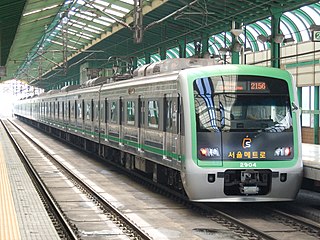
The Seoul Metropolitan Subway is a metropolitan railway system consisting of 22 rapid transit, light metro, commuter rail and people mover lines located in northwest South Korea. The system serves most of the Seoul Metropolitan Area including the Incheon metropolis and satellite cities in Gyeonggi province. Some regional lines in the network stretch out to rural areas in northern Chungnam province and western Gangwon province, that lie over 100 km away from the capital, as well as Suwon.

Korea Railroad Corporation, promoted as KORAIL (코레일), is the national railway operator in South Korea. Currently, KORAIL is a public corporation, managed by Ministry of Land, Infrastructure and Transportation.
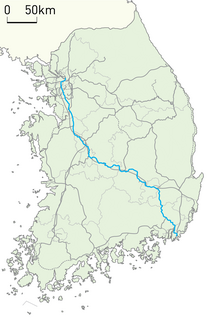
The Gyeongbu Line (Gyeongbuseon) is the most important railway line in South Korea and one of the oldest ones in the country. Gyeongbu line was constructed in 1905, connecting Seoul with Busan, via Suwon, Daejeon, and Daegu. The Gyeongbu Line is by far the most heavily travelled rail line in South Korea.
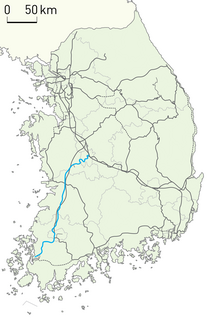
The Honam Line is a major railway line serving the Honam region in South Korea. The line is served by frequent passenger trains from Seoul to Gwangju and Mokpo.
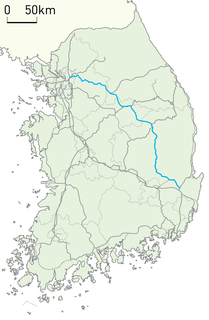
The Jungang line is a railway line connecting Cheongnyangni in Seoul to Gyeongju in South Korea, traversing central South Korea from the northwest to the southeast. It also referred to the rail line of the Seoul Metropolitan Subway from Yongsan station to Yongmun station.

Korea Train eXpress is South Korea's high-speed rail system, operated by Korail. Construction began on the high-speed line from Seoul to Busan in 1992. KTX services were launched on April 1, 2004.

The Gyeongjeon Line (Gyeongjeonseon) is a railway line serving South Gyeongsang and South Jeolla Provinces in South Korea. It covers a total of 300.6 km, from Samnangjin Station in Miryang, South Gyeongsang, to Gwangju·Songjeong Station in Gwangju, South Jeolla.

Seongnam is the second largest city in South Korea's Gyeonggi Province after Suwon and the 10th largest city in the country. Its population is approximately one million. Seongnam is a satellite city of Seoul. It is largely a residential city located immediately southeast of Seoul and belongs to the Seoul National Capital Area.

The Yeongdong Expressway is an expressway in South Korea. Numbered 50, it connects the Seoul area with Gangwon Province. It is named from Yeongdong, an old name for Gangwon. The road has its western end in Namdong-gu of Incheon Metropolitan City. Its eastern end lies in Gangneung near the east coast. From Incheon to Gangneung, the expressway covers 234.39 kilometers.

The Yeongdong Line is a line of Korail. It connects Yeongju in North Gyeongsang Province with Gangneung in Gangwon Province. From Yeongju, it crosses the Taebaek Mountains and reaches the Sea of Japan at Donghae, thence proceeding north to Gangneung.

AREX, spelled A'REX as a brand name, is a South Korean commuter rail line that links Incheon International Airport with Seoul Station via Gimpo International Airport. The section between the two airports opened on March 23, 2007, the extension to Seoul Station opened December 29, 2010. Korea Train Express high speed trains started to use the line from June 30, 2014 and discontinued in March 2018 due to low ridership.
Pangyo refers to a planned city surrounding Pangyo-dong, Baekhyeon-dong, Unjung-dong, and Sampyeong-dong of Bundang-gu and Siheung-dong and Sasong-dong of Sujeong-gu.
The Suryeo Line is a former narrow-gauge railway line owned by Korean National Railroad. The line connected Suwon to Yeoju.

The Gyeongbu high-speed railway between Seoul and Busan is South Korea's first high-speed rail line. KTX high-speed trains operate three sections of the line: on April 1, 2004, the first between a junction near Geumcheon-gu Office Station, Seoul and a junction at Daejeonjochajang Station north of Daejeon, and a second between a junction at Okcheon Station, southeast of Daejeon, and a junction near Jicheon Station, north of Daegu entered service; then on November 1, 2010, the third section, between a junction west of Daegu and Busan became operational. The missing gaps across the urban areas of Daejeon and Daegu are in construction for an expected opening in 2014, separate tracks into Seoul Station are planned. The temporary ends of the three sections are connected to the parallel conventional Gyeongbu Line by tracks that will serve as interconnector branches upon the completion of the entire line.
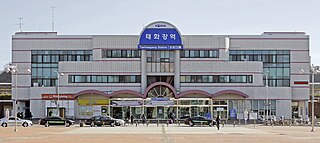
Taehwagang Station, meaning Taehwa River Station, is a train station located in Samsan-dong, Nam-gu, Ulsan. It was previously named Ulsan Station until the KTX Ulsan station opened on November 1, 2010.

Incheon International Airport Terminal 1 Station is a railway station on AREX and Incheon Airport Maglev. It is in Incheon International Airport's transport center and currently the terminus. Since June 2014, KTX operated from this station with stops at Geomam Station and Seoul Station towards Busan and Gwangju. Before the KTX opened services at this station, there was high-leveled platform which had no use. Since this time, only this platform didn't have platform screen doors because there was a plan for a 2nd airport railroad to go there, but this plan changed to KTX. After that, KTX started to run, they have changed the empty platform to a low leveled-platform to make KTX rideable. In the same year, KTX expanded service to Incheon Airport. Since 2018 KTX service to Incheon Airport has been suspended despite signage in both Terminal 1 and Terminal 2 saying otherwise. The suspension became permanent in September 2018 as the line was officially abolished. Travelling to cities other than Seoul via rail is now only available after a transfer at Seoul Station via the AREX.

Pangyo Station is a station on the Shinbundang Line, serving the planned city of Pangyo in the city of Seongnam. The station is close to Pangyo Techno Valley, one of the country's largest clusters of software, gaming, entertainment and biotechnology businesses, home to major tech companies like Kakao. It began operations on October 28, 2011, with the opening of the Shinbundang Line.

Gangneung Station is a railway station on the Yeongdong Line in Gyo-dong, Gangneung, Gangwon, South Korea. All Seatrains and Mugungwha trains stopped at this station until September 14, 2014 when it was closed because of the construction of the Gyeonggang Line. Because of this, all Mugungwha trains terminated at Jeongdongjin Station.
The Jungbu Naeryuk Line (중부내륙선) or Center Inland Line is a rail line under construction from Bubal to Mungyeong. Construction started in November 2015. The line is expected to open in 2019 to Chungju, and then in 2021 to Mungyeong.
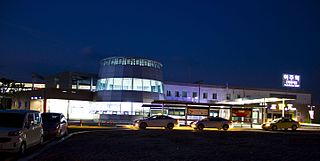
Yeoju Station is a railway station on Gyeonggang Line of the Seoul Metropolitan Subway.



















